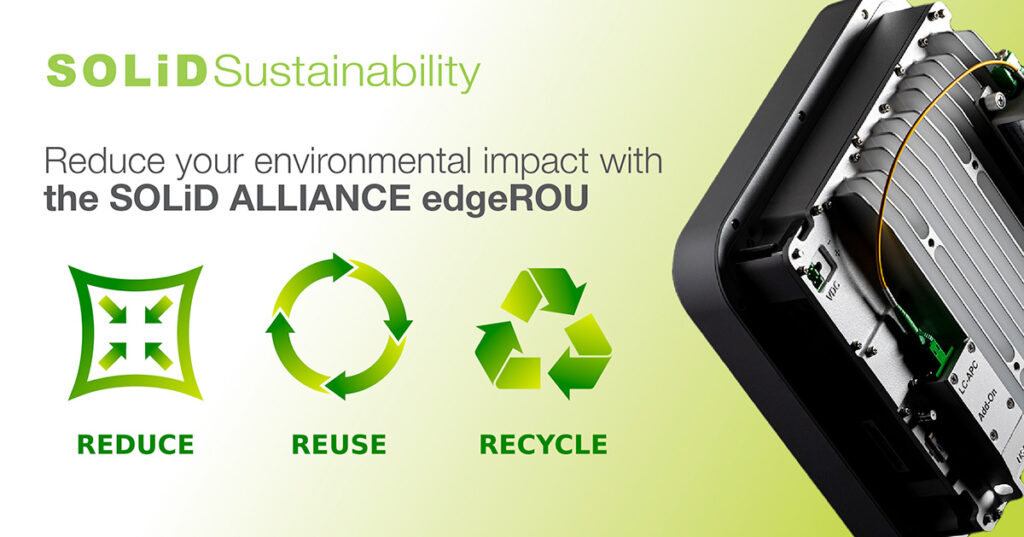Sustainability has become an urgent focus for many enterprises, governments, and communities worldwide. Yet as connectivity demands escalate, overall communications network electricity usage continues to rise. This means it is increasingly difficult for network operators to achieve sustainability goals and building owners to meet and building emissions compliance requirements on the road to achieving Net-Zero emissions.
At SOLiD, this emphasis on sustainability is nothing new. In fact, we have a history of offering reliable, sustainable DAS solutions that contribute to a greener planet in several ways.
On Track to Sustainability
SOLiD sustainability begins with engineering excellence, resulting in DAS solutions designed to deliver the highest performance with the lowest carbon footprint. For example, the ALLIANCE edgeROU DAS platform supports the fully-occupied 280 MHz of the C-Band while consuming a maximum of 35 watts — just one-third the amount of energy required for alternative fiber-to-the-edge DAS remotes, despite providing a much higher RF output power.
Each edgeROU remote supports the entire bandwidth of up to four frequency bands, allowing each remote unit to accommodate more spectrum, frequency bands, and services from the public cellular networks. This means that in-building network managers need fewer SOLiD DAS remotes to achieve the same coverage and capacity as competing solutions. Plus, the ALLIANCE edgeROU is the smallest active DAS remote available.
As a result, with each remote consuming less energy, being smaller, lighter in weight, and with fewer remotes needed overall for seamless coverage, far fewer resources are consumed in manufacturing, shipping, and operating the ALLIANCE edgeROU platform. This makes it the industry’s “greenest” active DAS solution and the most affordable with a low total cost of ownership (TCO). Likewise, our SOLiD ALLIANCE high-power remote optic unit (HROU) solutions, such as the Mid-Band HROU_4000, include a power-saving function, allowing them to reduce power when traffic demand is low.
Together, these technologies reflect SOLiD’s broader commitment to sustainable distributed antenna systems that balance energy efficiency with long-term network performance.
Modular Momentum
In addition to reducing resource consumption, there is another important aspect to the SOLiD sustainability track record as well. Because the SOLiD ALLIANCE platform is modular, network operators and building owners can easily replace, reuse, and upgrade individual components as needed to keep up with evolving telecom technologies, such as today’s 5G and tomorrow’s 6G mobile networks. This eliminates the significant time, expense, and waste generated by a rip-and-replace project to swap out an entire non-modular DAS system.
Moreover, the modularity of SOLiD DAS equipment allows us to ship all the system components to one place, where we assemble the head-ends before delivering the assembled system to our customer’s site. This enables us to recycle the component packaging rather than leaving that responsibility to network operators or system integrators who may not have ready access to recycling facilities.
Sustainable DAS Innovation
For our society to achieve needed Net-Zero goals, we all have to do our part, including network operators, building owners, system integrators, and suppliers. Sustainable network solutions and practices provide powerful tools to aid the decarbonization of the worldwide economy — reducing the network’s carbon footprint and helping businesses make better choices to build a more sustainable model for the future.
For 25 years, SOLiD has continuously innovated to deliver best-in-class solutions for a globally complex, ever-evolving telecommunications industry. As rising connectivity demands drive the need for greater global sustainability, we will continue to innovate to deliver the most reliable, sustainable, and high-performance connectivity solutions on the market. To learn more, visit: solid.com/us/products/alliance-das.
